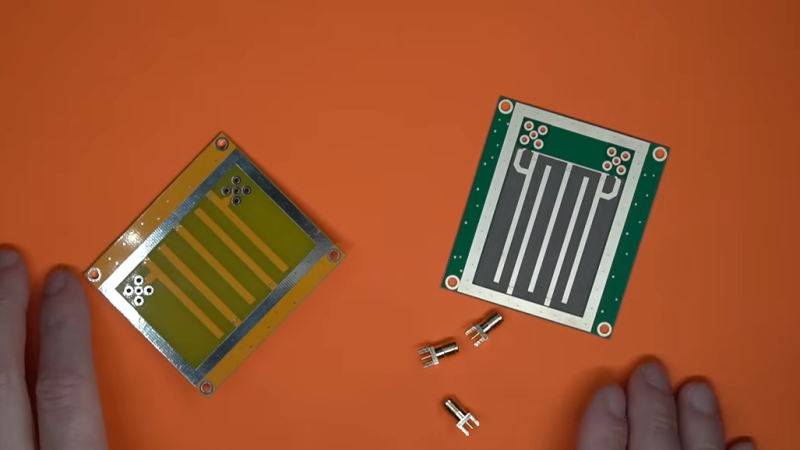We’ve always been fascinated by things that perform complex electronic functions merely by virtue of their shapes. Waveguides come to mind, but so do active elements like filters made from nothing but PCB traces, which is the subject of this interesting video by [FesZ].
Of course, it’s not quite that simple. A PCB is more than just copper, of course, and the properties of the substrate have to be taken into account when designing these elements. To demonstrate this, [FesZ] used an online tool to design a bandpass filter for ADS-B signals. He designed two filters, one using standard FR4 substrate and the other using the more exotic PTFE.
He put both filters to the test, first on the spectrum analyzer. The center frequencies were a bit off, but he took care of that by shortening the traces slightly with a knife. The thing that really stood out to us was the difference in insertion loss between the two substrates, with the PTFE being much less lossy. The PTFE filter was also much more selective, with a tighter pass band than the FR4. PTFE was also much more thermostable than FR4, which had a larger shift in center frequency and increased loss after heating than the PTFE. [FesZ] also did a more real-world test and found that both filters did a good job damping down RF signals across the spectrum, even the tricky and pervasive FM broadcast signals that bedevil ADS-B experimenters.
Although we would have liked a better explanation of design details such as via stitching and trace finish selection, we always enjoy these lessons by [FesZ]. He has a knack for explaining abstract concepts through concrete examples; anyone who can make coax stubs and cavity filters understandable has our seal of approval.















“Hello, and welcome back” is the best youtube introduction I think.
Short, to the point, true in many cases, and funny for new viewers that are not ‘back’ since they are new. (well, funny to those that share my sense of humour).
Also, Fesz is a great teacher. No fluff, good explanations with both theory and practice (sim and actual circuits & measurements). He makes complex topics understandable like it is as simple as it can only be in hindsight.
Brilliant video!
My ruler which I leave at work is a PCB one with the various patterns and templates including a few high frequency filters and genuinely blows people’s mind when they see it (and ask what it is).
I no longer work in a tech field so we all see it as even more magical.
He covers highlights nuisance/ sensitivity to build features well, and its super disappointing when you buy an antenna or PCB antenna off of AliExpress and it somehow fails to perform compared to the same product from the same manufacturer a few months ago (oddly specific but it still bothers me).
For an explanation of things not covered in the video, I recommend the “Black Magic “ books by Johnson & Graham. Also “Planar Microwave Engineering” by Lee if you need more background material.
Johnson & Graham can easily read by themselves if you were paying close attention in 2nd semester Physics EM theory. Lee is the greatest RF book ever. The AoE of radio. All 3 books belong in your EE library.
FR4 is a problem for high accuracy electronics because epoxy has poor properties. There are more than a thousand varieties of epoxy and they’re going to behave differently. If the epoxy isn’t thoroughly cured, its properties are going to change with heat and age. Epoxy suffers from dielectric absorption, and to a lesser extent so does the glass in FR4.